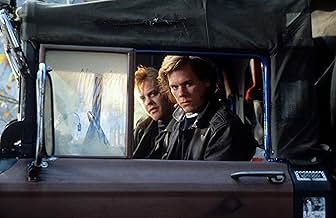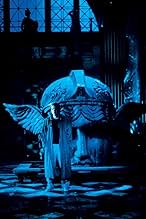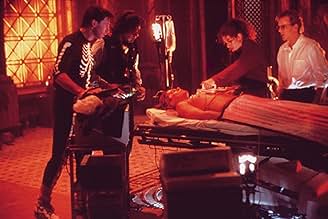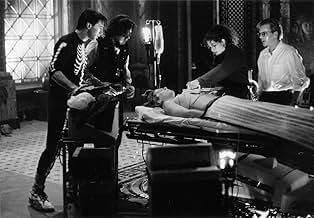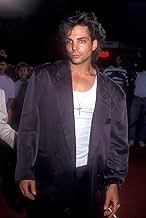IMDb-BEWERTUNG
6,6/10
95.459
IHRE BEWERTUNG
Vier Medizinstudenten experimentieren mit "Nahtod"-Erfahrungen, bei denen sie mit tragischen Ereignissen aus der Vergangenheit konfrontiert werden, die auf gefährliche Weise beginnen, ihr Le... Alles lesenVier Medizinstudenten experimentieren mit "Nahtod"-Erfahrungen, bei denen sie mit tragischen Ereignissen aus der Vergangenheit konfrontiert werden, die auf gefährliche Weise beginnen, ihr Leben zu beeinflussen.Vier Medizinstudenten experimentieren mit "Nahtod"-Erfahrungen, bei denen sie mit tragischen Ereignissen aus der Vergangenheit konfrontiert werden, die auf gefährliche Weise beginnen, ihr Leben zu beeinflussen.
- Für 1 Oscar nominiert
- 3 Nominierungen insgesamt
John Duda
- Young Labraccio
- (as John Joseph Duda)
Handlung
WUSSTEST DU SCHON:
- WissenswertesJulia Roberts (Dr. Rachel Mannus) and Kiefer Sutherland (Nelson Wright) started dating during filming. They ended up engaged, but Roberts ultimately broke it off. She later married Lyle Lovett.
- PatzerWhile a defibrillator is of no use if a patient has truly flatlined, a patient in a "fine v-fib" rhythm can appear to have flatlined but still be revived with the paddles. Therefore, when in doubt, the Advanced Cardiac Life Support guidelines call for administering the shock, though it's not the treatment of choice.
- Zitate
[first lines]
Nelson Wright: Today is a good day to die.
- SoundtracksPARTY TOWN
Written and Performed by David A. Stewart (as Dave Stewart)
Courtesy of BMG Records (UK) Ltd.
Ausgewählte Rezension
I've been intending to write a review of this film for some time, but only now have I actually managed to get my thoughts down for the perusal of others.
I never had the pleasure of seeing this film on the `big screen' which is a shame, as it is often visually stunning, but I have revisited it on video numerous times over the years, enjoying it immensely every time. It definitely is on my personal list of favorite movies, and for more than just starring Kiefer Sutherland and Kevin Bacon, two of my `actors to watch.'
Perhaps I appreciate this film so much because it appeals to my slightly off-kilter taste in entertainment. I like my movies a bit left of center - unpredictable and fresh. And whether or not you `believe' the story line of the film, you have to admit, it is different!
Everyone has different tastes and opinions, but my impression of some of the negative reviews of this movie is that the viewers never really saw past the surface level of this film. They got caught up in technicalities, `Why would there be green lighting in a subway?' or `Why would medical students pull such a stupid stunt?' and failed to see the artistry and psychological depth of the piece.
Yes, there are some medical and technical aspects that do not make logical sense, but if you are willing to suspend disbelief just a tad, this can be a very engaging film.
First, a note about the artistic quality of the movie. Some have complained about the murky lighting, and the illogical nature of the sets - but for me, the use of innovating lighting techniques, the plastic and sheet draped sets, the unusual settings in old buildings and dank, dripping tunnels, the use of statuary, rain and billowing curtains - all add a poetic flavor to this film, a haunting beauty that suits the dark nature of the questions being asked about life, death and forgiveness.
I will focus on just two examples; in an alley scene, a change in lighting allows for certain elements of the set to come dramatically into focus, then to fade away once lighting returns to normal. It is an innovative means of conveying a shift in the `reality' of the moment, and works beautifully. We are also allowed to see the interior of the character's apartments - contrast the warm wood, bright colors, golden lighting and cluttered comfort of Labraccio's rooms with the stark, white void of Nelson's. Both are reflective of the characters themselves. Nelson's lack of `objects' reflect our lack of knowledge about his past. and his carefully constructed mask that keeps his companions at a distance. His past, we come to learn, is one of chaos and conflict. He has determined to leave that behind in favor of an uncluttered emptiness. unfortunately, the emptiness is also reflective of his relationships with others, a realization he comes to along his personal journey of self-discovery in this film.
Flatliners is not your typical horror film. Nor is a typical drama or suspense movie.it is rather more of an amalgamation of all, having the best elements of all genres intertwined in a complex, suspenseful plot.
This is an ensemble piece, and the cast does an excellent job of breathing life into their individual characters. Your immediate impression is that the characters are each representative of a well-established `stereotype': The female ice queen, the slightly neurotic 'physician', the playboy and the socially conscious `nice guy' etc. However, as the film progresses and the characters are further fleshed out, they take on multiple dimensions and depth.
Most interesting of all is Sutherland's character of Nelson. Nelson is not a character that is easy to like - indeed he is a bit of a b**tard, a master manipulator who definitely places self-interest above all else. Yet, Sutherland plays him with a hint of insecurity that lends him a certain appeal. As events unfold, you come to realize that much of Nelson's unpleasant personality is a smokescreen, a protective mask behind which hides a very uncertain and vulnerable young man burdened by a terrible secret.
By revealing bits and pieces of Nelson's complex personality throughout the film, the writers, directors and cast gradually lead you towards a greater understanding of and sympathy for him. The character who started out as a `jerk' becomes important and valued in his own right - as you learn to `forgive' his previous behavior in light of new information. Your journey of discovery with Nelson reflects the characters own journeys towards self-understanding, as they too come to realize that everyone has value, and `everything we do matters.'
Which leads to my final comment. Although many of the posters here have picked up upon the theme of defying death.. few seem to have touched upon what I see as the main premise of the movie - the importance of forgiveness, and the need to be cognizant of all you do, because it does `matter.'
I never had the pleasure of seeing this film on the `big screen' which is a shame, as it is often visually stunning, but I have revisited it on video numerous times over the years, enjoying it immensely every time. It definitely is on my personal list of favorite movies, and for more than just starring Kiefer Sutherland and Kevin Bacon, two of my `actors to watch.'
Perhaps I appreciate this film so much because it appeals to my slightly off-kilter taste in entertainment. I like my movies a bit left of center - unpredictable and fresh. And whether or not you `believe' the story line of the film, you have to admit, it is different!
Everyone has different tastes and opinions, but my impression of some of the negative reviews of this movie is that the viewers never really saw past the surface level of this film. They got caught up in technicalities, `Why would there be green lighting in a subway?' or `Why would medical students pull such a stupid stunt?' and failed to see the artistry and psychological depth of the piece.
Yes, there are some medical and technical aspects that do not make logical sense, but if you are willing to suspend disbelief just a tad, this can be a very engaging film.
First, a note about the artistic quality of the movie. Some have complained about the murky lighting, and the illogical nature of the sets - but for me, the use of innovating lighting techniques, the plastic and sheet draped sets, the unusual settings in old buildings and dank, dripping tunnels, the use of statuary, rain and billowing curtains - all add a poetic flavor to this film, a haunting beauty that suits the dark nature of the questions being asked about life, death and forgiveness.
I will focus on just two examples; in an alley scene, a change in lighting allows for certain elements of the set to come dramatically into focus, then to fade away once lighting returns to normal. It is an innovative means of conveying a shift in the `reality' of the moment, and works beautifully. We are also allowed to see the interior of the character's apartments - contrast the warm wood, bright colors, golden lighting and cluttered comfort of Labraccio's rooms with the stark, white void of Nelson's. Both are reflective of the characters themselves. Nelson's lack of `objects' reflect our lack of knowledge about his past. and his carefully constructed mask that keeps his companions at a distance. His past, we come to learn, is one of chaos and conflict. He has determined to leave that behind in favor of an uncluttered emptiness. unfortunately, the emptiness is also reflective of his relationships with others, a realization he comes to along his personal journey of self-discovery in this film.
Flatliners is not your typical horror film. Nor is a typical drama or suspense movie.it is rather more of an amalgamation of all, having the best elements of all genres intertwined in a complex, suspenseful plot.
This is an ensemble piece, and the cast does an excellent job of breathing life into their individual characters. Your immediate impression is that the characters are each representative of a well-established `stereotype': The female ice queen, the slightly neurotic 'physician', the playboy and the socially conscious `nice guy' etc. However, as the film progresses and the characters are further fleshed out, they take on multiple dimensions and depth.
Most interesting of all is Sutherland's character of Nelson. Nelson is not a character that is easy to like - indeed he is a bit of a b**tard, a master manipulator who definitely places self-interest above all else. Yet, Sutherland plays him with a hint of insecurity that lends him a certain appeal. As events unfold, you come to realize that much of Nelson's unpleasant personality is a smokescreen, a protective mask behind which hides a very uncertain and vulnerable young man burdened by a terrible secret.
By revealing bits and pieces of Nelson's complex personality throughout the film, the writers, directors and cast gradually lead you towards a greater understanding of and sympathy for him. The character who started out as a `jerk' becomes important and valued in his own right - as you learn to `forgive' his previous behavior in light of new information. Your journey of discovery with Nelson reflects the characters own journeys towards self-understanding, as they too come to realize that everyone has value, and `everything we do matters.'
Which leads to my final comment. Although many of the posters here have picked up upon the theme of defying death.. few seem to have touched upon what I see as the main premise of the movie - the importance of forgiveness, and the need to be cognizant of all you do, because it does `matter.'
Top-Auswahl
Melde dich zum Bewerten an und greife auf die Watchlist für personalisierte Empfehlungen zu.
Details
- Erscheinungsdatum
- Herkunftsland
- Sprache
- Auch bekannt als
- Línea mortal
- Drehorte
- Museum of Science & Industry - 57th & Lake Shore Drive, Jackson Park, Hyde Park, Chicago, Illinois, USA(exteriors: Tait Building)
- Produktionsfirmen
- Weitere beteiligte Unternehmen bei IMDbPro anzeigen
Box Office
- Budget
- 26.000.000 $ (geschätzt)
- Bruttoertrag in den USA und Kanada
- 61.489.265 $
- Eröffnungswochenende in den USA und in Kanada
- 10.034.685 $
- 12. Aug. 1990
- Weltweiter Bruttoertrag
- 61.489.638 $
- Laufzeit1 Stunde 55 Minuten
- Farbe
- Sound-Mix
- Seitenverhältnis
- 2.39 : 1
Zu dieser Seite beitragen
Bearbeitung vorschlagen oder fehlenden Inhalt hinzufügen

Oberste Lücke
What is the streaming release date of Flatliners - Heute ist ein schöner Tag zum Sterben (1990) in Canada?
Antwort


